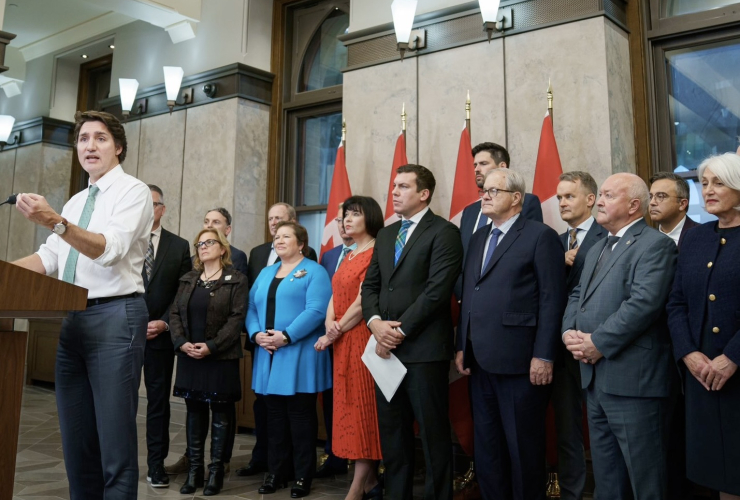Edmonton's Capital Power Corp. and Ontario Power Generation are joining together to assess the feasibility of developing small modular nuclear reactors to help power Alberta's electricity grid.
At an announcement Monday in Edmonton, the two companies said small modular reactors, or SMRs, will be critical in the years to come if Canada and Alberta are to meet growing demand for clean electricity.
They said the feasibility assessment will take two years to complete and will include exploring ownership and operating structures for a potential fleet of grid-scale SMRs in Alberta.
"Creating a carbon-neutral energy system that prioritizes reliability and affordability while accommodating growing demand is one of the most unprecedented transitions of our time," said Capital Power CEO Avik Dey at Monday's announcement.
"Nuclear energy is, and must be, a critical part of the clean energy transition, and part of our power generation fleet here in Alberta if we are to become carbon-neutral."
Small modular reactors are a type of nuclear technology that is far smaller, cheaper and faster to build than a traditional nuclear reactor. They are fully scalable — usually in the range of 10 to a few hundred megawatts — and can be built to suit a wide variety of applications.
SMRs remain largely untested on a commercial scale, but proponents believe their time has arrived. Ontario Power Generation is already building North America's first fleet of SMRs at the Darlington nuclear site in Ontario, with the first of these four 300 MW units is expected to be complete by 2028 and online by the end of 2029.
Last year, the federal government through the Canada Infrastructure Bank committed almost $1 billion to the Darlington project.
While the company has not yet publicly released an estimated capital cost for its Darlington SMRs, Ontario Power Generation CEO Ken Hartwick said small-scale nuclear is far more affordable than a conventional nuclear plant and represents a realistic opportunity to help decarbonize Canada's electricity grid.
"I'm very convinced this is comparable (in cost) with wind, solar, batteries or any combination of those," Hartwick said Monday.
"With Ontario and Alberta leading on this, along with other provinces that are looking . . . I really do think we can make a difference."
In Canada, four provinces — New Brunswick, Ontario, Saskatchewan and Alberta — have agreed to collaborate on the advancement of SMRs as a clean energy option, and Canadian researchers are working on new materials and designs that could make SMRs practical in a large range of new uses.
SMRs have even been touted as a potential solution for Alberta's oilsands, one that could replace the vast volumes of fossil fuels burned in the oilsands production process.
Monday's announcement about SMRs came after a weekend of bitterly cold temperatures strained the capacity of Alberta's electrical system. The province's grid operator appealed to consumers to preserve power in order to prevent rotating blackouts.
Alberta's Utilities Minister Nathan Neudorf said the situation was a reminder of how important it will be to ensure the province's electricity grid has the right mix going forward.
Alberta, which has very little hydroelectric generating capacity but a rapidly expanding wind and solar power footprint, still depends heavily on fossil fuels in the form of natural gas for electricity generation.
SMRs are appealing, Neudorf said, because they provide the type of consistent base-load power that will be needed to backstop more intermittent clean power sources such as solar and wind in the future.
"SMRs will soon play a role in growing our economy and reducing our emissions," Neudorf said.
"I think it makes it makes great sense for Alberta to be looking at this, especially given their investment in renewables," said Jacquie Hoornweg, a clean energy expert with the Canadian Global Affairs Institute.
"Having a small modular reactor in the system means that you can get the most out of your renewables when you're operating, but you have that base-load or load-following capability that is also low-carbon."
The challenges facing the deployment of SMRs in Canada include regulatory hurdles, as well as whether commercial-scale projects can be completed on budget. Recently, an Oregon-based company called NuScale cancelled a proposed SMR project south of the border, citing concerns around escalating costs.
But Hoornweg said the real appeal of the technology is the way it can be scaled up or down as needed.
"There are a lot of places in Alberta for sure that may not be able to benefit from a traditional-scale reactor, but there are many regional centres as well as many off-grid or very specific-purpose uses where a small modular reactor could make a lot of sense," she said.
"The potential here is huge, in terms of being an enabler of decarbonization in Alberta."
Capital Power, which has set its own goal of achieving net-zero greenhouse gas emissions by 2045, is also pursuing greenhouse gas abatement in the form of a proposed carbon capture and storage project at its Genesee natural gas-fired power plant.
In an interview Monday, Dey said carbon capture is a more near-term decarbonization solution than SMRs, but there's no time to waste even on longer-term technologies.
"It's really important that we start on our journey with SMRs and nuclear now, because the lead times are so long," Dey said.
"The biggest hurdle is we don't have an existing regulatory and permitting process specific and bespoke to Alberta. This is new to Alberta, it's new to Albertans — we need to work through that process."
This report by The Canadian Press was first published Jan. 15, 2024.
Companies in this story: (TSX:CPX)
Might help, but it will get a
Might help, but it will get a generation before ready. Renewables Danielle
"7 reasons why nuclear energy
"7 reasons why nuclear energy is not the answer to solve climate change"
Mark Z. Jacobson
Professor of Civil and Environmental Engineering & Director of the Atmosphere/Energy Program, Stanford University
"There is a small group of scientists that have proposed replacing 100% of the world’s fossil fuel power plants with nuclear reactors as a way to solve climate change. Many others propose nuclear grow to satisfy up to 20 percent of all our energy (not just electricity) needs. They advocate that nuclear is a “clean” carbon-free source of power, but they don’t look at the human impacts of these scenarios. Let’s do the math..."
https://www.oneearth.org/the-7-reasons-why-nuclear-energy-is-not-the-ans...
What a lotta hype - enough
What a lotta hype - enough hot air to drive a wind farm. Those of us who grew up in the 50's have been here before. The promise is "smaller, faster, cheaper, safer" And SMR in every municipality [chicken in every pot?]. The reality was larger, slower, more expensive, and Chernobyl, Three Mile Island, etc. To say nothing of the still unsolved waste problem. This is a capital intensive solution driven by those who would make money out of this crisis, not solve the problem. And fusion-power is an even worse case.
So:
A Smart Gird with widely distributed small scale sources owned by a large fraction of the populous - day-time solar plus storage; on and off wind plus storage; geothermal as base load; inter-grid transfers as base load, and so on.
Let's change the slogan: A solar panel on every roof! A windmill in every rural back yard. A geothermal unit in every apartment block!
Residential solar and arrays
Residential solar and arrays of solar panels on commercial and industrial buildings are a huge untapped energy resource with tremendous, almost unlimited potential. In addition, there are many exciting developments and innovations happening in the world of battery technology (e.g. sodium ion batteries), as well as solar and wind technology which will revolutionize these industries and hopefully make them even more environmentally sustainable and cheaper to manufacture and install. It’s time for governments to actively encourage, promote, and incentivize the installation of solar panels on residential, commercial and industrial buildings. Imagine the result if the government, through the Canada Infrastructure Bank, had committed almost one billion dollars to a program that incentivizes small scale solar on buildings throughout the country, rather than towards the development of SMR and CCS projects.
It remains to be seen if the two technologies being touted in this article (SMRs & CCS ) will actually pan out and at what cost. There are many unanswered questions and concerns about both of these technologies, and much green-lighting, but governments are spending billions of taxpayer dollars on research and development anyway. I agree with your premise that this is all about making money for the “big players” - residential solar panels aren’t going to make the big boys rich.
I remember having to keep my children inside and out of the radioactive April rain that eventually came to the west coast after the Chernobyl disaster in the 1980s. The generation that was born after the Second World War was also the first to be exposed to the large amount of radioactive fallout from hundreds and hundreds of above ground nuclear weapons tests.
My own personal feeling about nuclear power is that people must be prepared to accept that in the event of a catastrophic failure at one of these facilities, they may have to leave their homes and communities forever. Think about that for a moment - forced to abandon your home and everything in it, your entire community; schools, community centres and parks, all infrastructure, everything! The catastrophic failure of a nuclear facility could be caused by human error, a severe earthquake and/or a tsunami, a terrorist attack, a war, or any number of other factors. It’s important to note that this isn’t just scare mongering as Chernobyl and Fukushima demonstrated so vividly; the war in the Ukraine has also seen the threat of a nuclear power plant being destroyed or severely damaged by the Russian military.
Lastly, as you point out, the persistent problem of what to do with the nuclear power industry’s stockpile of radioactive waste is an ongoing issue. Regardless of the eventual solution(s) to this problem, one can be sure that it will also involve huge sums of money in perpetuity.
Amanda please ask the what
Amanda please ask the what the plan to do with all the radioactive waste. Then point out that it will contain plutonium that can be used to make atomic bombs, so military security is needed for it.




Comments